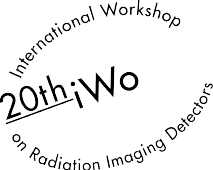Speaker
Description
Introduction
CdTe diode detector is an appealing sensor device for medical imaging applications, such as X-ray radiography, CT and so on. Particularly, room-temperature operation availability and high detection efficiency across the wide energy range, due to the large band-gap energy (1.44 eV) and the high atomic number (Cd:48, Te:52), are remarked for integrated sensors, i.e., line sensor and panel sensor [1]. While photon counting signal processing enables to measure the energy spectrum of photon of irradiated X-ray, it is difficult to implement large-size two-dimensional array of photon counting sensors because huge data traffic is required between sensors and computers.
In this study, we propose a novel method for realizing X-ray energy discrimination with accumulation-type CdTe flat panel detector (FPD). It utilizes the difference of the depletion layer thickness caused by the modulation of bias voltage applied on the diode detector. Because the thickness of depletion layer is proportional to the root of bias voltage, if the higher bias voltage is applied, the depletion layer gets thicker. The probability of interaction between the detector and X-ray increases as the thickness of the depletion layer increases, especially for higher energy X-ray. When the bias voltage is modulated per frames, we can obtain the images containing different energy information for each frame. This enables energy discrimination imaging like dual-energy CT [2] with a single typical X-ray source.
The characteristics of CdTe Schottky diode radiation detector at high bias voltage have already been investigated [3]. However, the characteristics at low bias voltage is not yet known well because very low pulse height from very slow carrier mobility. To make it clear, our group have investigated the characteristics of a single CdTe diode detector at low bias voltage, both theoretically and experimentally.
Analysis and experiment
Figure 1(a) shows a p-type CdTe Schottky diode with thickness $W$ , applied bias voltage $V$. Assuming injected X-ray with energy $h\nu$ is absorbed at distance $x$ from injection surface, charge collection efficiency $\eta$, in other words, the sensitivity of the detector to the radiation, is formulated as
$\eta(V, h\nu ) = \int_0^W \eta_H (V, x) \alpha_\gamma (h\nu) \exp(-\alpha_\gamma (h\nu) x) dx $
$\eta_H(V,x) = \frac{\lambda_n}{W} [ 1 - \exp (-\frac{x}{\lambda_n})] + \frac{\lambda_p}{W} [ 1 - \exp (-\frac{W-x}{\lambda_p})] $
where $\lambda_n$ and $\lambda_p$ are the mean free path of electrons and holes in the detector, respectively [3]. Figure 1(b) shows that the difference of the efficiency is significant where injection energy is greater than 100[keV], while less difference at 30 - 60[keV]. By comparing the efficiency ratio at 72[V] over 36[V], the ratio at 60[keV] is 1.16 while the ratio at 120[keV] is 1.36.
We have performed the spectrum measurement using multi-channel analyzer. Am241 and Eu152 are used as RI. Peak count around 59.5[keV] (Am241) and 122[keV] (Eu152) are measured for bias voltage 36[V] and 72[V]. While the peak count ratio around 59.5[keV] = 1.15 were in good agreement with the analysis result, the peak count ratio around 122[keV] was 1.69, which is larger than the analysis result. Compton scattering and interaction with electrodes should be considered for more precise analysis.
Reference
[1] Wenjuan. Zou, et al., Jpn. J. Appl. Phys., 2008, 47(9R), 7317-7327
[2] Johnson, et al. Eur Radiol (2007) 17: 1510.
[3] Kosyachenko et al, J. Appl. Phys. 113, 054504 (2013)




